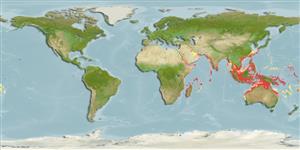>
Eupercaria/misc (Various families in series Eupercaria) >
Lutjanidae (Snappers) > Lutjaninae
Etymology: Lutjanus: Malay, ikan lutjan, name of a fish.
Eponymy: Rev Dr Christoph Samuel John (1747–1813) was a botanist and herpetologist and a medical missionary (1771–1813) at the Danish trading station of Tranquebar (now Tharangambadi), Tamil Nadu, not far from Madras (Chennai). [...] (Ref. 128868), visit book page.
More on author: Bloch.
Environment: milieu / climate zone / depth range / distribution range
Écologie
marin; saumâtre récifal; océanodrome (Ref. 51243); profondeur 0 - 80 m (Ref. 30573). Tropical; 31°N - 30°S, 30°E - 174°W (Ref. 55)
Indo-West Pacific: East Africa to Fiji, north to the Ryukyu Islands, south to Australia.
Length at first maturity / Taille / Poids / Âge
Maturity: Lm 51.9 range ? - ? cm
Max length : 97.0 cm TL mâle / non sexé; (Ref. 40637); common length : 50.0 cm TL mâle / non sexé; (Ref. 55); poids max. publié: 10.5 kg (Ref. 4699)
Épines dorsales (Total) : 10; Rayons mous dorsaux (Total) : 13 - 14; Épines anales: 3; Rayons mous anaux: 8. Dorsal profile of head steeply sloped. Preorbital width equal to eye diameter or larger. Preopercular notch and knob poorly developed. Scale rows on back parallel to lateral line. Center of each scale often with a reddish-brown spot, giving an overall appearance of series of horizontal lines on side of body. Generally yellow with a bronze to silvery sheen, shading to silvery white on belly and underside of the head. A large black blotch mainly above the lateral line below the anterior dorsal-fin rays.
Adults probably frequent coral reef areas; juveniles found in mangrove estuaries (Ref. 30573). Feed on fishes and benthic invertebrates including shrimps, crabs and cephalopods. In Hong Kong live fish markets (Ref. 27253).
Life cycle and mating behavior
Maturité | Reproduction | Frai | Œufs | Fécondité | Larves
Allen, G.R., 1985. FAO Species Catalogue. Vol. 6. Snappers of the world. An annotated and illustrated catalogue of lutjanid species known to date. FAO Fish. Synop. 125(6):208 p. Rome: FAO. (Ref. 55)
Statut dans la liste rouge de l'IUCN (Ref. 130435: Version 2024-2)
Menace pour l'homme
Harmless
Utilisations par l'homme
Pêcheries: commercial; Aquaculture: commercial; pêche sportive: oui
Outils
Articles particuliers
Télécharger en XML
Sources Internet
Estimates based on models
Preferred temperature (Ref.
123201): 25 - 29.1, mean 28.2 °C (based on 1824 cells).
Phylogenetic diversity index (Ref.
82804): PD
50 = 0.5000 [Uniqueness, from 0.5 = low to 2.0 = high].
Bayesian length-weight: a=0.01479 (0.01301 - 0.01682), b=2.96 (2.94 - 2.98), in cm total length, based on LWR estimates for this species (Ref.
93245).
Niveau trophique (Ref.
69278): 4.2 ±0.6 se; based on diet studies.
Generation time: 6.9 (5.2 - 9.5) years. Estimated as median ln(3)/K based on 10
growth studies.
Résilience (Ref.
120179): Milieu, temps minimum de doublement de population : 1,4 à 4,4 années (K=0.13-0.38).
Prior r = 0.40, 95% CL = 0.26 - 0.60, Based on 1 full stock assessment.
Fishing Vulnerability (Ref.
59153): High vulnerability (65 of 100).
Climate Vulnerability (Ref.
125649): Very high vulnerability (90 of 100).
Nutrients (Ref.
124155): Calcium = 19.6 [12.3, 28.3] mg/100g; Iron = 0.256 [0.165, 0.398] mg/100g; Protein = 18.9 [17.4, 20.2] %; Omega3 = 0.131 [0.095, 0.177] g/100g; Selenium = 69.1 [44.6, 104.8] μg/100g; VitaminA = 113 [19, 416] μg/100g; Zinc = 0.428 [0.346, 0.572] mg/100g (wet weight); based on
nutrient studies.
